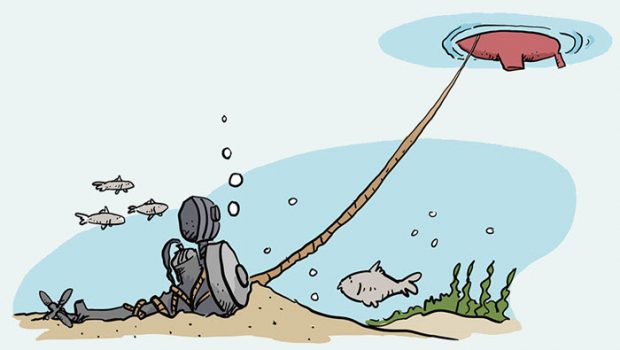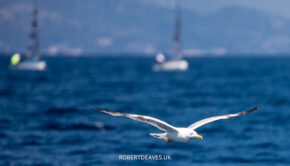Ode To A ‘Gull
Published on April 14th, 2022
by Chris Caswell
I was skimming a boating blog when my eye was caught by a plaintive headline: “How do I stop a Seagull?”
I thought for a moment and then I started laughing, to the point of tears running down my face and She Who Must Be Obeyed (SWMBO) leaving the kitchen to see if I was having a seizure.
The British Seagull was an outboard engine so simple that it required black arts to make it run and, once running, it was nigh impossible to stop.
The Seagull reached its zenith back in the ‘60s when they were selling 80,000 a year of these one-cylinder, two-strokers (production ended in the ‘90s), and they powered a lot of small sailboats like my parent’s Cal-20, as well as dinghies. It was devilishly simple, and had no covers or cowlings like “modern” outboards, so everything was right there to be seen, from the sparkplug wire to the rapidly spinning flywheel.
Woe betide any skipper who had a loose sleeve near this whirling dervish, because it had a voracious appetite for both sweaters and foul-weather gear. It also had no heat protection, and many of the parts were as hot as your stove, but not so well protected. I am a proud member of the Brotherhood of the Crescent, a clan joined together by a curved burn scar on my forearm much like the brand on cattle, made by bumping a hot Seagull. It’s not a particularly elite group, however.
The Seagull was unique for its starting procedure, which was truly a mystical art. As I recall, you opened the fuel shutoff valve, pushed a little piece of tin to cover the carb as a choke, pulled the engine thru once to flood it, opened the choke, and pulled the starter cord again.
I don’t think I’ve ever seen a Seagull manual, but I understand that the factory recommended starting procedure is to kill a chicken, turn three times clockwise, and then yank the starter cord smartly, as the Brits say.
Ah, the starter cord. This was an engine that didn’t understand the concept of “recoil starter”. British Seagull competitors all had starter cords that pulled out and then returned neatly into the engine housing. But, the Seagull had no engine housing. And no recoil, either.
To start the Seagull, you wrapped a 3-foot length of knotted cord around a notch in the top of the flywheel, gave it a hearty yank and the Seagull might or might not start. If not, you re-wrapped and tried it again. And again. And again.
The danger here was that the knotted end of the cord, after spinning the flywheel, would sweep behind the operator like a whip. One user thought he had impressed his girlfriend with his might, but found instead that she was weeping because he had lashed her across the face. In a dinghy with a Seagull, the safe place to sit is in the very bow, far from the range of the starter cord. Even better, on the dock.
But that brings up another point: most Seagulls had neither reverse or neutral. Once you managed to fire up the Seagull, you were immediately underway. More than a few people innocently holding the dock line for a Seagull-powered dinghy have been yanked off a dock or sailboat transom.
Seagulls, with their 10-1 gas/oil mix, left a haze of blue smoke and an oil slick on the water that would make a Coast Guard officer blanch and then run for his oil spill citation book. But, in a pinch, it’s said you could run a Seagull on stove alcohol, several cheap brands of island rums, or even cooking oil with the French fries removed.
The gas tanks on the early Seagulls were of soldered brass which soon gleamed through the scuffed black paint, and to say they leaked is to say that Niagara is a waterfall. They leaked through the filler cap, they leaked through the gas shutoff (a misnomer if ever there was) and they sometimes leaked through the carb just to be ornery.
In high school, I worked for a boat dealer who sold Seagulls mostly for inflatable tenders, and we were told that Seagulls were used at Dunkirk to ferry retreating British soldiers off the beach. We quickly realized that it would have been better for the troops to keep their weapons and leave the Seagulls on the beach because, if the Germans had tried to use them, it would have ended the war quickly.
The Royal Navy had asked for an outboard that was “rough and ready”, able to run non-stop for 24 hours. There was no problem with Seagulls running endlessly: it was getting them started or stopped that took some talent. Like proper English maidens, however, they occasionally fainted.
I learned to sail in dinghies, but having a Seagull was my graduate course in boathandling, and it taught me to never entirely trust an engine. To always have a Plan B. And a Plan C. British Seagulls were so undependable that they taught a generation of us to handle our boats with confidence in all situations.
Like most pilots, I learned to fly in single-engined airplanes but, being a sailor, it wasn’t long before I was drawn to soaring. Once you were released from the tow plane, you were on your own. You couldn’t just add power to climb over a hill that was in the way, and I learned more about flying from gliding without power than I did from all my hours behind a spinning prop.
It’s no surprise to me that Sully Sullenberger, the pilot who landed his crippled airliner on the Hudson River after all the engines failed, was also a glider pilot. The Seagull was my nautical equivalent of gliding, because you had to plan ahead, be prepared, and keep your wits when things go pear-shaped.
Returning a 50-foot charter boat to the island base, we were motoring down a narrow and dead-ended slipway when our engine suddenly quit. In the deafening silence that followed, my crew looked at about a zillion dollars worth of yachts on each side, and started to rush around to hang out fenders in preparation for the sound of splintering fiberglass.
Years of Seagull to the rescue. “No worries,” I said, “I got this one.” Judging it to the foot, I spun the big wheel hard, our boat did a pirouette and our last vestiges of speed melted away as we greased into the slip, barely moving. The crew stepped off, lines were cleated, and we all grinned at each other. Even the charter base team, hardened by every possible bit of clumsy seamanship, applauded. Take a bow, British Seagull.
So how do you stop a Seagull?
In theory, you could just shut off the fuel, which would kill it in an hour or two. But, since the sturdy four-bladed prop was still spinning, that wasn’t realistic in most situations.
One way was to put your hand over the carb air intake but, if it happened to backfire before stopping, it would install a perfectly round (and quite painful) blister on your palm. Another way was to pull the plug wire but if it wasn’t absolutely insulated (and it rarely was), this would provide great amusement to anyone watching as you did a St. Vitus dance from a blast of electricity.
I knew one Seagull owner who kept a short length of 2×4” lumber that he would shove…carefully…into the prop to stall the engine.
When it came to working on a Seagull, there were two trains of thought. One said that anything could be fixed with screwdriver, pliers, and duct tape. The other was that you needed a set of British Standard Whitworth wrenches which also matched the bolts used on many vintage English cars and motorcycles.
To this day, I have a full set of Whitworths in my shop but, since SWMBO isn’t going to approve another old British car, they should probably be donated to the Smithsonian. When it came to the spark plug gap, we used a TLAR gauge: That Looks About Right.
Speaking of British Cars, Seagulls also introduced Americans to several traits of English cars. First, they mark their territory by leaking oil on everything: garage floors, cockpit lockers, car trunks, everywhere. Second, they used a British electrical system that came to be known as the Prince of Darkness. Joke: Why do the British drink warm beer? Because they have refrigerators with British wiring.
Today’s helicopter parents would faint at the thought of turning their snowflakes loose in a dinghy with a Seagull and all its hot moving parts, but my pre-teen cronies and I blew through gallons of oily gas every summer with only the occasional burn or shredded sweater.
We ran them up onto beaches with the props spinning madly like mini Cuisinarts. We dropped more than a few in the drink but, rinsed off, they would run as if nothing had ever happened so we didn’t have to explain the mishap to our parents. The Seagull taught a generation of sailors about boat handling, and I never get in a dinghy even today that doesn’t have oars.
Thinking back on the Seagulls I’ve owned, I wish I had one now. Smelly, noisy, and oily, Seagulls were like an aging favorite dog with fleas and mange: you loved it anyway. I’d hang the Seagull on my wall like a museum piece, just so I could look at it.
I’d laugh and relive my childhood memories, mostly good and some great.









 We’ll keep your information safe.
We’ll keep your information safe.